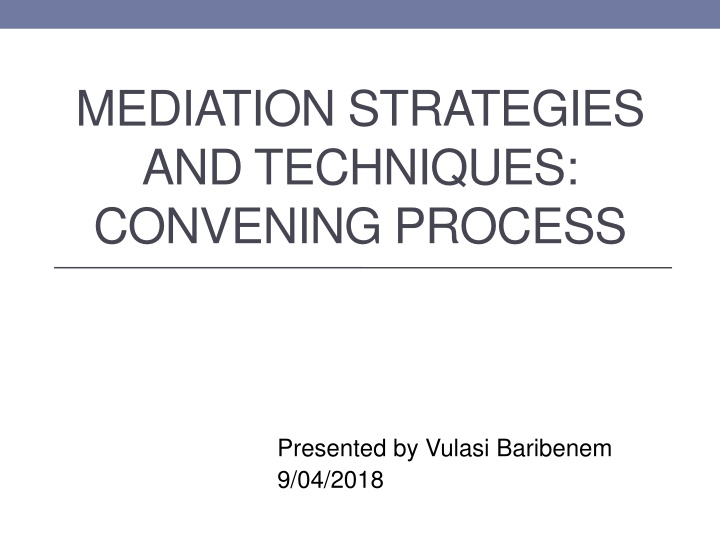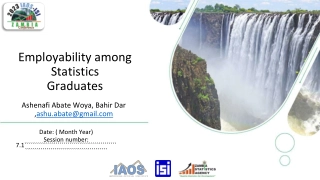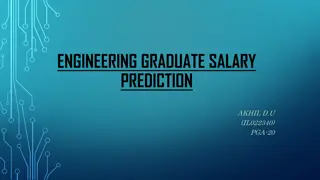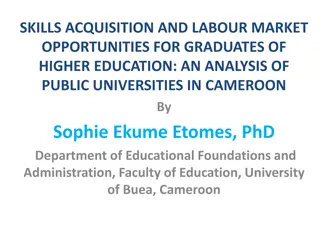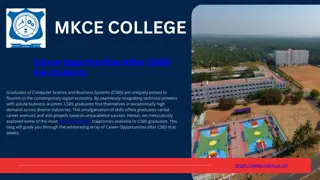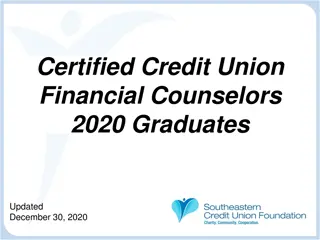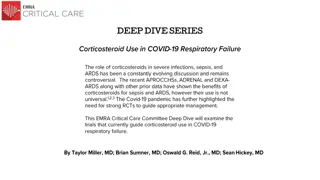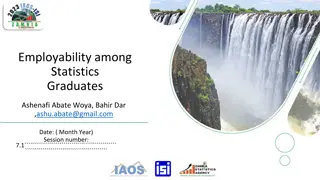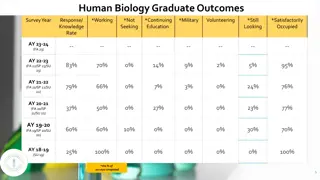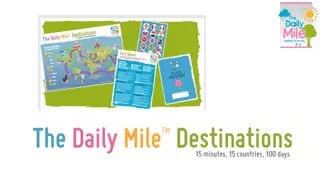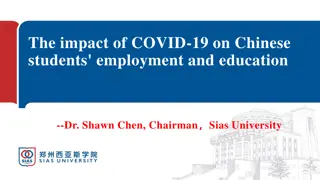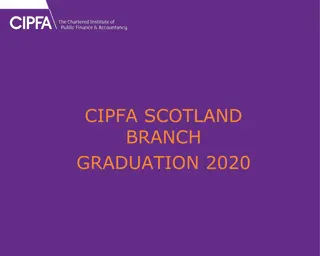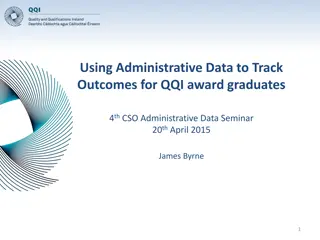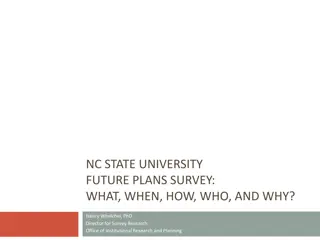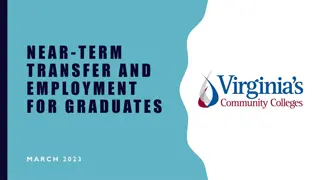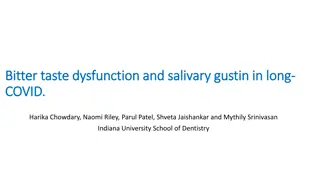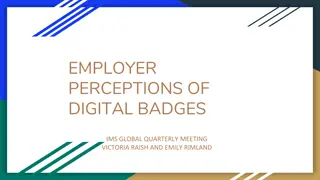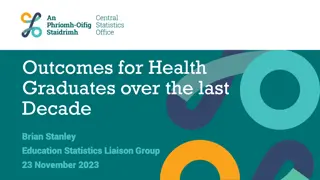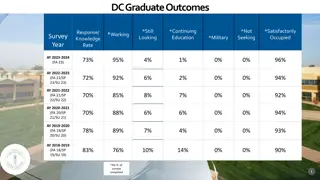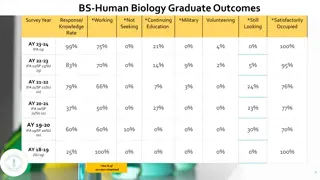Impact of COVID on Recent Graduates: First Destinations Analysis
Reflecting on the impact of COVID-19 on recent graduates from 2019 to 2023 across various colleges and universities, including disruptions, employment rates, further education pursuits, and post-graduate activities. Explore the trends in first destinations at Grinnell College, Iowa State University, and Cornell College, highlighting shifts in outcomes over the years.
Download Presentation

Please find below an Image/Link to download the presentation.
The content on the website is provided AS IS for your information and personal use only. It may not be sold, licensed, or shared on other websites without obtaining consent from the author.If you encounter any issues during the download, it is possible that the publisher has removed the file from their server.
You are allowed to download the files provided on this website for personal or commercial use, subject to the condition that they are used lawfully. All files are the property of their respective owners.
The content on the website is provided AS IS for your information and personal use only. It may not be sold, licensed, or shared on other websites without obtaining consent from the author.
E N D
Presentation Transcript
MEDIATION STRATEGIES AND TECHNIQUES: CONVENING PROCESS Presented by Vulasi Baribenem 9/04/2018
2 Saturday, 15 March 2025 TABLE OF CONTENT What is convening? Convening process Responsibility of the convener Characteristics of a convener Four key steps in convening process
3 Saturday, 15 March 2025 What is convening? The Merriam Webster dictionary defines convening as the coming together of people in a group for a meeting process. Put simply, it means to come together in a body. Whereas the Cambridge dictionary defines convening as the act of bringing a group of people together for a meeting, or to meet for a meeting
4 Saturday, 15 March 2025 CONVENING PROCESS In conflict intervention convening is the first stage in which disputants come together with a third party. The convening process usually occurs as preliminary meeting where disputants gather to discuss the issues of the conflict and consider options for resolution of the problem. The purpose of the gathering is to discuss the conflict and decide on a course of action.
5 Saturday, 15 March 2025 CONVENING PROCESS Its objective is to pave the way for an actual conflict resolution process such as mediation, negotiation or consensus building. The convener has the responsibility to ensure that whatever conflict resolution process chosen proceeds smoothly and works effectively.
6 Saturday, 15 March 2025 RESPONSIBILITY OF THE CONVENER Thus the convener has the responsibility to assess the conflict situation, 1. identify key stakeholders and participants, 2. introduce options for a resolution process, 3.
7 Saturday, 15 March 2025 RESPONSIBILITY OF THE CONVENER CONTD. 4. distinguish resource needs and funding sources, 5. choose an appropriate venue. A skillful, careful and effective convening process increases the chances of successfully implementing an agreement.
8 Saturday, 15 March 2025 CHARACTERISTICS OF A CONVENER A convener must be credible, unbiased, and trustworthy this is usually key in seemingly intractable conflicts. The convener should also be knowledgeable of the issue at hand. The convener of the first meeting may or may not be a stakeholder in the problem, however, the main role of the convener is to identify and bring all stakeholders to the table.
9 Saturday, 15 March 2025 CHARACTERISTICS OF A CONVENER Conveners usually start the process but do not necessarily conduct the process. In order words once an initial meeting is arranged, the convener's job is usually over. However conveners sometimes play the role of facilitator in negotiation. The convener must have legitimacy in the eyes of the stakeholders.
10 Saturday, 15 March 2025 Convening at Different Scales Convening is a necessary first step before any mediation or consensus-building process, either at interpersonal, community, or international level. The general principles of convening applies to all these levels. One key difference however is that in large and complex public policy cases, as well as international cases convening takes longer because stakeholder representatives is a critical issue. Whereas at local level it is fairly easy to identify stakeholder as respected leaders can be identified.
11 Saturday, 15 March 2025 FOUR STEPS IN CONVENING PROCESS CONFLICT ASSESSMENT STAKEHOLDER INDENTIFICATION OBTAIN RESOURCES PROCESS DESIGN
12 Saturday, 15 March 2025 CONFLICT ASSESSMENT The initial step is to assess the conflict situation. Here the first tasks is to identify the conveners aim/goals. The convener is also required to identify and define issues of the conflict and then frames the problem in a way all parties understand. The convener should also know the limit of his authority, to formalize and implement any agreement that may be reached by the convened group.
13 Saturday, 15 March 2025 STAKEHOLDER IDENTIFICATION Another key aspect is the identification of stakeholders. The stakeholder should identify key stakeholder holders i.e. those affected by the issues. The convener must also determine what potential resource needs will arise during the actual negotiation process. Next, the convener must determine if and how these needs can be met. The process may also be aborted if key stakeholders refuse to participate in the process. Once key stakeholders have been identified, they must decide on their representatives. The convener is responsible for ensuring that key parties are sufficiently and legitimately represented.
14 Saturday, 15 March 2025 OBTAIN RESOURCES The third major step is to locate the necessary resources to carry out the convening. In other words, the convener is charged with developing a funding strategy. The convener's first move may be to research philanthropic or governmental agencies in order to find sources of funding. If the convener is a government official or agency there may already be funds available to carry out a decision making process. Most small scale situations demand that the convener locate and apply for funding, usually in the form of grants.
15 Saturday, 15 March 2025 PROCESS DESIGN This is the final step in the convening process, here the objective is to organize and plan the dispute resolution process which will begin with the initial meeting the convener has organized. Ground rules must ne set and agreed upon by every one, an agenda is set and a strategic plan developed. A key to this part of the convener's job is to make sure that the agreements reached will be linked or incorporated into official decision-making structures In the case of more formal conflict resolution negotiations, for example reaching a peace accord, it is likely that the proper structure of governance will be readily identifiable and maybe even involved in the convening process itself.
16 Saturday, 15 March 2025
MEDIATION STRATEGIES AND TECHNIQUES: OPTION IDENTIFICATION Presented by Vulasi Baribenem 9/04/2018
Option Identification Option identification occurs after the issues of the problem have been identified. Subsequently ALL available options (including ones that a party would normally not choose) to reaching an agreement are listed. It is a relevant step in the process of resolving any conflict and it is essential through all phases of the conflict.
How To Identify Options The mediator or negotiator has the responsibility to help opposing parties identify and develop options for resolving conflict. It is necessary to have a third party involved in the process because he/she will assist parties to identify options they may not identify on their own. The goal is to come up with numerous alternatives.
How To Identify Options In order to generate wise options for resolving a conflict, the parties must first reveal the interests that lie behind their positions. Rather than making demands and focusing on concessions, more options are generated if parties are forthcoming about their underlying concerns and what they hope to achieve.
How to identify options In order for parties to create options for resolving their conflicts, they must first understand one another s interest. There are several procedure to doing this, however they all share a common characteristics. First everyone present is encouraged to suggest options. Second parties try to separate the process of generating options from that of assessing options. Then third parties focus on discussing issues and not themselves.
Ways of creating options Ratification of the status quo: this involves the revision and updating of a previously reached agreement. This means that options can be created when an already reached agreement is reviewed in order to make corrections and update it. The development of objective standards for an acceptable agreement: while this does not necessary create options, it establishes mutually accepted standard for the creation of options and reaching a final agreement.
Ways Of Creating Options Brainstorming: the idea behind this is that more people will create more options. Here the mediator frames an issue as a problem and then asks the how question in order to get responses which will serve as options. Open discussion: this is considered one of the best methods of creating options. Parties can make suggest ideas without committing themselves to it.
Ways Of Creating Options Nominal group process: is similar to brainstorming, but aims to maximize individual creativity. Just like brainstorming the issue is stated as a "how" problem, individuals make their own lists of solutions within a given time limit and then form small groups of about five, in which they share and record their ideas one at a time. They select those options that have the potential for mutual acceptance, and then present them to the larger group for further discussion and consideration. Task group; it often used alongside other methods. Here issues divided into logical categories and separate task groups identify options for each category. This process is usually used in cases where there are a wide range of issues and when some of them require special knowledge and/or expertise.
Ways of creating options Single text negotiation: rather than have disputants discuss the issues and generate ideas separately, the entire group works with one document, which may be developed by the mediator after hearing both sides' concerns and then the documents are given to all parties to make modifications. model agreements: the parties examine agreements made in other disputes that were similar to their current situation. Those models are then explored and changed to meet the needs of the present situation. Linked trades: is a procedure that involves identifying potentially connected (linked) issues and then trading specific things that each party values differently.
Ways of creating options Other ways of creating options include: procedural solutions procedural solutions outside experts or resources
